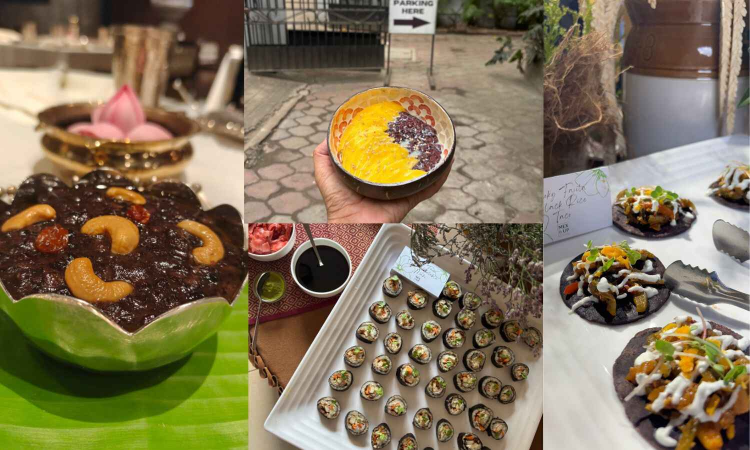Purple on the Plate: Karuppu kavuni black rice finds a place in Chennai’s modern kitchens
With its vibrant hue, earthy flavour, and nutritional punch, Tamil Nadu’s heirloom karuppu kavuni rice (black rice) is becoming a star ingredient in restaurants and home kitchens

Variety of dishes at Mex It Up
CHENNAI: Chef Kavya Verghese is someone who puts in a lot of effort and thought into curating dishes at her restaurant, Mex It Up, located in Teynampet. Instead of using the usual Thai sticky rice, Kavya has turned to Tamil Nadu’s own karuppu kavuni rice to make the famous mango sticky rice. The dish, with its deep purple hue and local connection, has been quickly well-received on the menu. Recently, she curated a menu for a small event where karuppu kavuni rice was the main ingredient. In this feature, we take a look at how karuppu kavuni rice (black rice) is making inroads into Chennai kitchens in various forms, from tacos and sushi to porridges. The list is endless.
“When Spirit of the Earth asked me to curate a menu for an event, I was really excited. Since I specialise in different cuisines, it was a great opportunity for me. We made tacos, sushi, mango sticky rice, cookies, a bread loaf…everything with karuppu kavuni rice. It’s such a versatile grain: it adds colour, texture, and it’s incredibly nutritious,” says Kavya.
At her restaurant, Kavya continues to serve mango sticky rice with this heirloom grain “Usually, we use Japanese sticky rice, but I wanted to experiment with something local. When I tried karuppu kavuni, it had the same sticky texture as Japanese rice. I added it to the menu, and it was an instant hit. Many diners ask why the mango sticky rice is deep purple in colour, and I love telling them it’s Tamil Nadu’s heirloom black rice. While it’s not quite as sticky as Japanese rice, it offers a similar texture with a gentle, pleasant stickiness. Pairing any fruit with coconut milk is always refreshing, but with black rice, the dish becomes more colourful, flavourful, and distinctly local. It is a perfect twist on a global classic,” she smiles.
Kavya adds that black rice is highly nutritious and a better alternative to white rice, which is heavily processed. “No type of rice is ideal for daily consumption. It’s important to balance your meals and control portion sizes. You can include black rice in your diet two or three times a week,” she says.
Once powdered, black rice can be stored and used to make chapatis, desserts, crumbles, quiches, pies, and more, says Kavya. “Many people think you can make only a few traditional dishes with kavuni rice, but that’s not true. It works across cuisines. That’s why I’ve been experimenting: I’ve even made pasta dough with it. I’ve been trying to promote this rice for a while. Some customers are already aware of it, while others are still discovering it. We make it a point to explain and encourage them to try,” she adds.
A nutritious alternative that's slowly finding its way into both home and gourmet kitchens, black rice is also being explored by home cooks. City-based accountant Binoja uses it occasionally. “Since it takes a long time to cook, I mostly make porridges with black rice. I’ve been meaning to experiment more and try a few different dishes. The cooking time is definitely one of its drawbacks," shares Binoja.
Chef Kannan recommends soaking black rice for at least six hours, or up to 12 hours for the best results. “It’s best to soak it overnight, which makes it much easier to cook. At the hotel, we mostly prepare payasam and halwas with black rice. If guests request in advance, we also make dosas, healthy salads, and rice bowls. In the Chettinad region, this traditional rice variety is still widely used," he says.
Kavya Verghese; Kannan Thanikasalam



